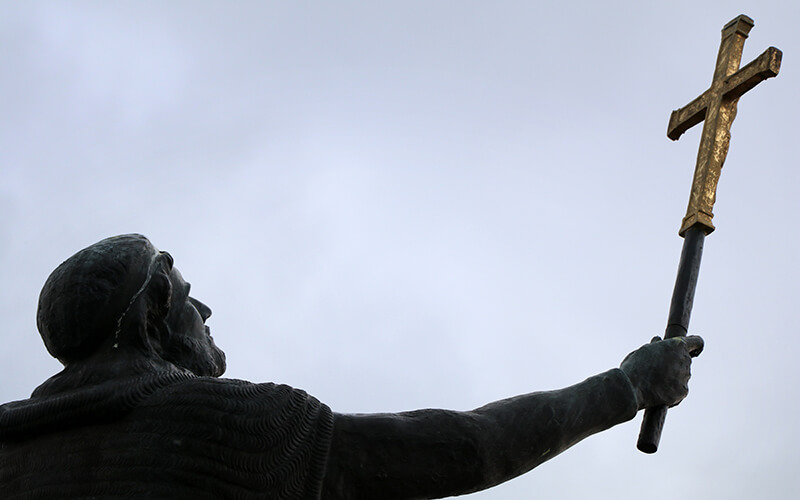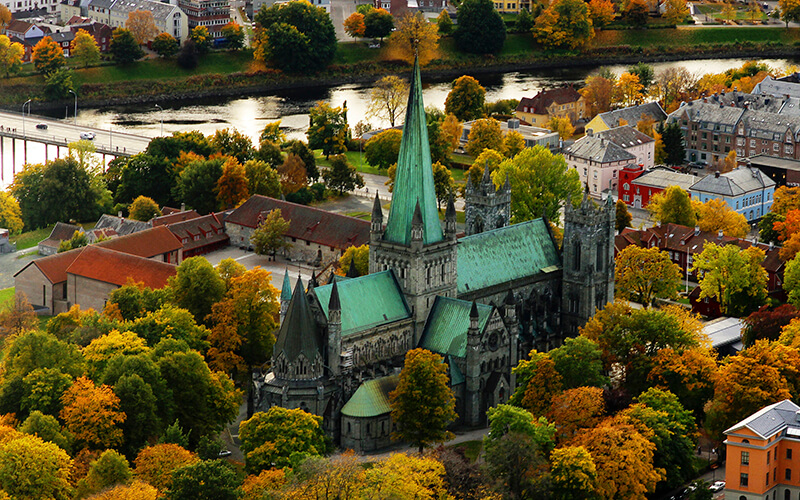About St. Olav
The story of Olav Haraldsson – is based on fables and tales but also a few credible sources. Somewhere around the years 1230 – 1240, the Icelandic historian and author Snorri Sturluson wrote the Tales of the Nordic Kings, and one of the books is called “The tale of Olav the holy”, written 200 years after the death of Olav Haraldsson.
Olav Haraldsson was born in the year 995 in Ringerike, in today’s southern Norway. Olav was born into a family of great local influence, a family which most likely had long been part of the local history. When Olav was 12 years old, he departed on what we today might call an educational journey. Olav was to learn to become a skilled Viking, with all that this might entail. Sailing, seamanship and also trade, power, politics and warfare. The journey took him to the Baltic Sea and then onwards to England, by now together with a larger Danish Viking army. In the year 1011, Olav took part in the siege of Canterbury which resulted in the English paying 48,000 pounds to the Danes – the largest ransom ever.
Left the Aesir faith
Olav ended up with Duke Richard III in Normandy, where it is believed that Olav received part of his political education that would serve him well when he returned to Norway to become king. It is believed that he was advised to marry into the royal family of one of the neighbouring countries, to ensure he was “protected” in case of war. In Normandy, in the town of Rouen, Olav Haraldsson was also baptised and thus converted from the Aesir faith (a belief in Norse mythology) to Christianity. This is likely to have taken place in 1014 and is of course a pivotal event in this story. Olav left England in 1015 to returned, to unify Norway under a common king.
With the help of legislation, Christianity and the sword, Olav managed to unite Norway and make it a Christian country where legislation would protect even the weakest members of society. Olav married into the family that ruled the area that was to become Sweden. The Swedish king was called Olof Skötkonung and he had a daughter called Ingegerd. Following some political complications Ingegerd actually ended up marrying Yaroslav the grand prince of Novgorod (which the Vikings called Holmgaard). So, Olav married Astrid instead, an illegitimate daughter of Olof Skötkonung.
Two years in exile
Olav’s strong monarchical grip and strict legislation lead to resistance and enemies among the people and especially from the Danish king. In 1028 Olav Haraldsson felt obliged to leave the country. He fled from Norway and made his way to Novgorod where Ingegerd lived – is it possible that Olav and Ingegerd had a real love affair?
After two years in exile in today’s Russia, Olav heard that some of his worst enemies in Norway were dead. So, he decided to return to Norway to reclaim the crown. Exactly which route he chose is not really clear, but he probably passed the islands of Åland and stepped ashore in Selånger which was an important port in the Middle Ages. He most likely travelled through Frösön in Jämtland before finally reaching the small village of Stiklestad where the great battle of Norway would take place. The battle took place on July 29 in the year 1030 and Olav died.
After the battle
Almost immediately after his death rumours started to circulate about miracles that had happened surrounding Olav. His body was moved to current day Trondheim – called Nidaros at the time – and his coffin was buried in the sandy bank of the Nidelven river. Stories started to abound, such as blind people regaining their eyesight when walking along the Nidelven river. On August 3, 1031, i.e. a year after Olav’s death, Bishop Grimkjell came to Nidaros. Olav’s coffin was exhumed. A scent of roses arose from the coffin, Olav’s ginger beard had grown, and his cheeks were flushed red. The bishop then realised that Olav Haraldsson was no simple Viking king, and Olav Haraldsson then became Olav the Holy. His coffin was moved to the small Klemens church of Nidaros and construction of the fantastic Nidaros cathedral began.
Christian pilgrims from all over the world started to make the journey to Nidaros Cathedral and up until the 17th century Nidaros was one of Northern Europe’s most important pilgrim sites. In 1544, King Gustav Vasa’s Lutheran regime prohibited pilgrimages in Sweden. Thus the pilgrim trail was forgotten, the local story of Olav lived on and since the 1980s there has been a rising interest in pilgrimages in Europe. In September 2013, the St. Olavsleden pilgrim trail was re-opened, and once again hundreds of hikers from all over the world can walk in the footsteps of St. Olav, trough historical landscape towards Nidaros Cathedral.



Stories along St. Olavsleden
Canonisation

A year after the Battle of Stiklestad, Olav’s body was exhumed. The bishop pronounced him a holy man with the support of the populace. Olav was canonised as a martyr. His death for Christianity was seen as certain proof that he was God’s instrument. He was honoured as an apostle of Norway for completing the long process of Norway’s Christianisation. This unique combination of martyr and apostle is perhaps the foremost reason why Olav gained such as strong and wide following. Olav was a highly popular saint and appealed to all groups of society.
Shelters

Overnight accommodation for pilgrims was built along St. Olavsleden, known as “soul shelters”. The pilgrims drank from cold springs along the route, which were named after St. Olav. Legend has it that the springs appeared when Olav struck his staff on the ground, making water flow from the earth. The spring water was believed to promote good health, another incentive for making the pilgrimage. The most famous St. Olav springs are in Borgsjö and Pilgrimstad. You can still drink cold, refreshing water from the springs while breathing fresh air.
Nidaros

The oldest preserved parts of Nidaros Cathedral are Romanesque from the mid-12th century. Nidaros Cathedral has been renovated several times – predominantly in the Gothic style – after being damaged by fire. Sit on a bench outside and study the west wall of the cathedral. Sculptures on the wall depict scenes including the Crucifixion and, at the top, Christ’s Ascension. 400,000 people visit Nidaros Cathedral every year from all over the world.

